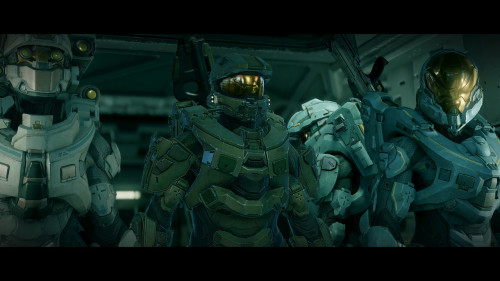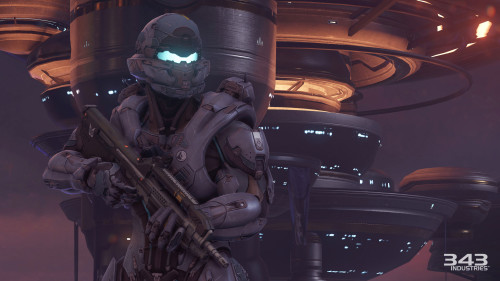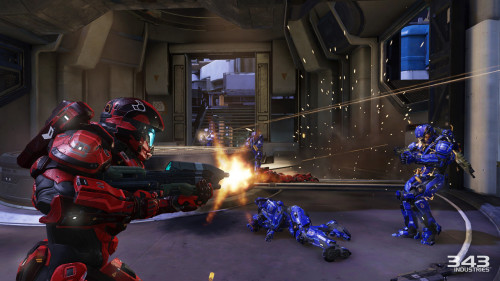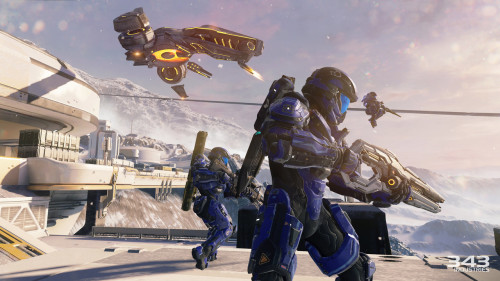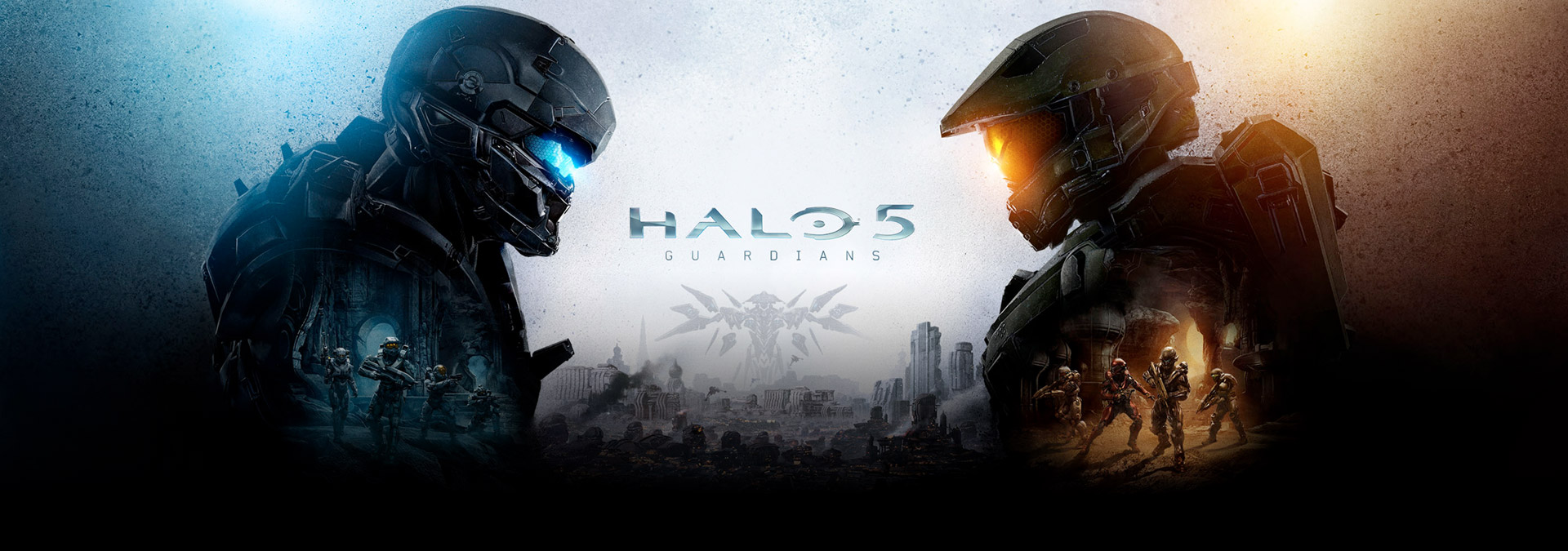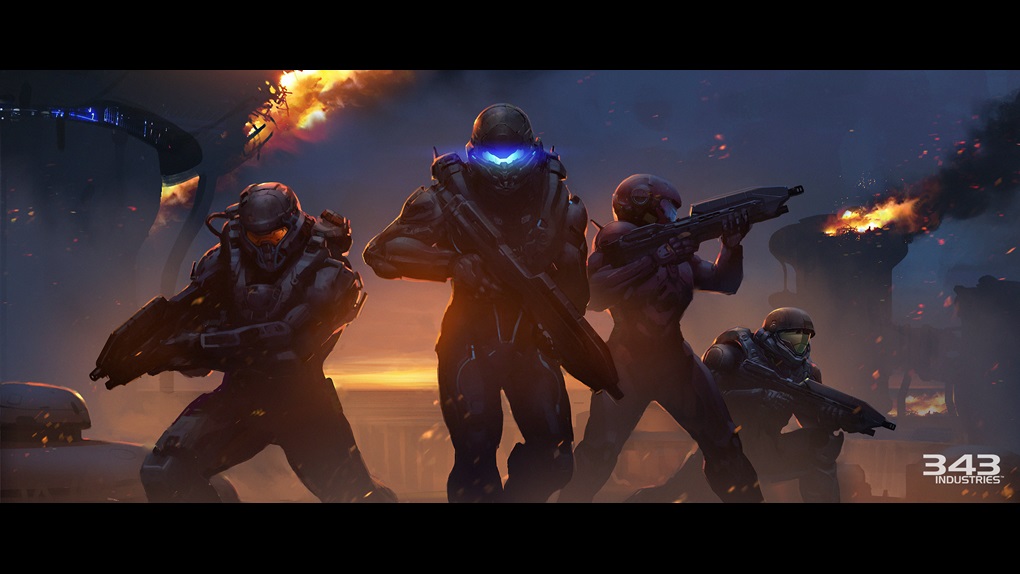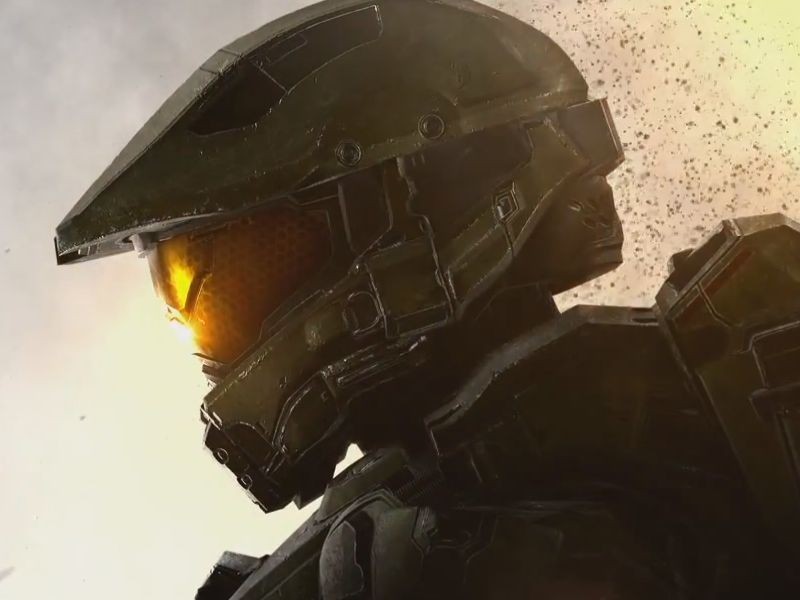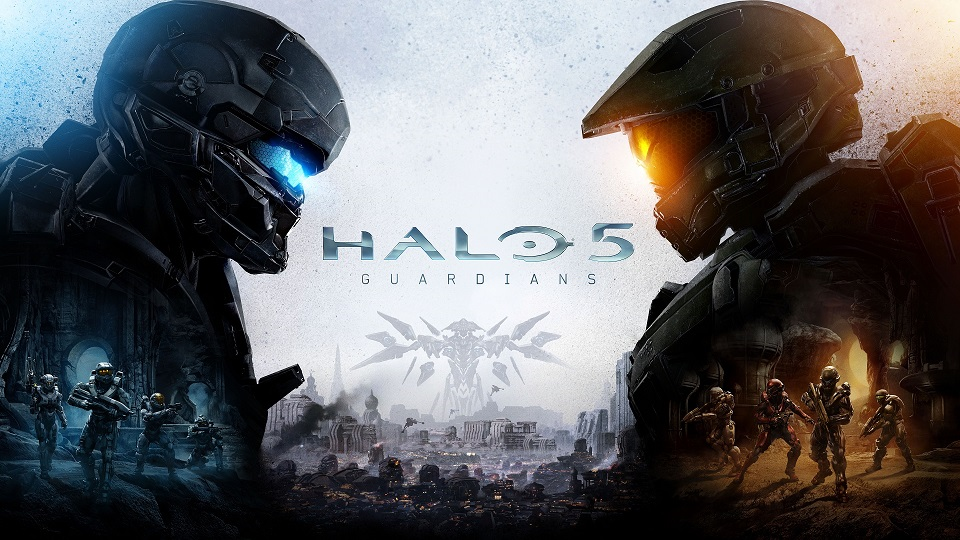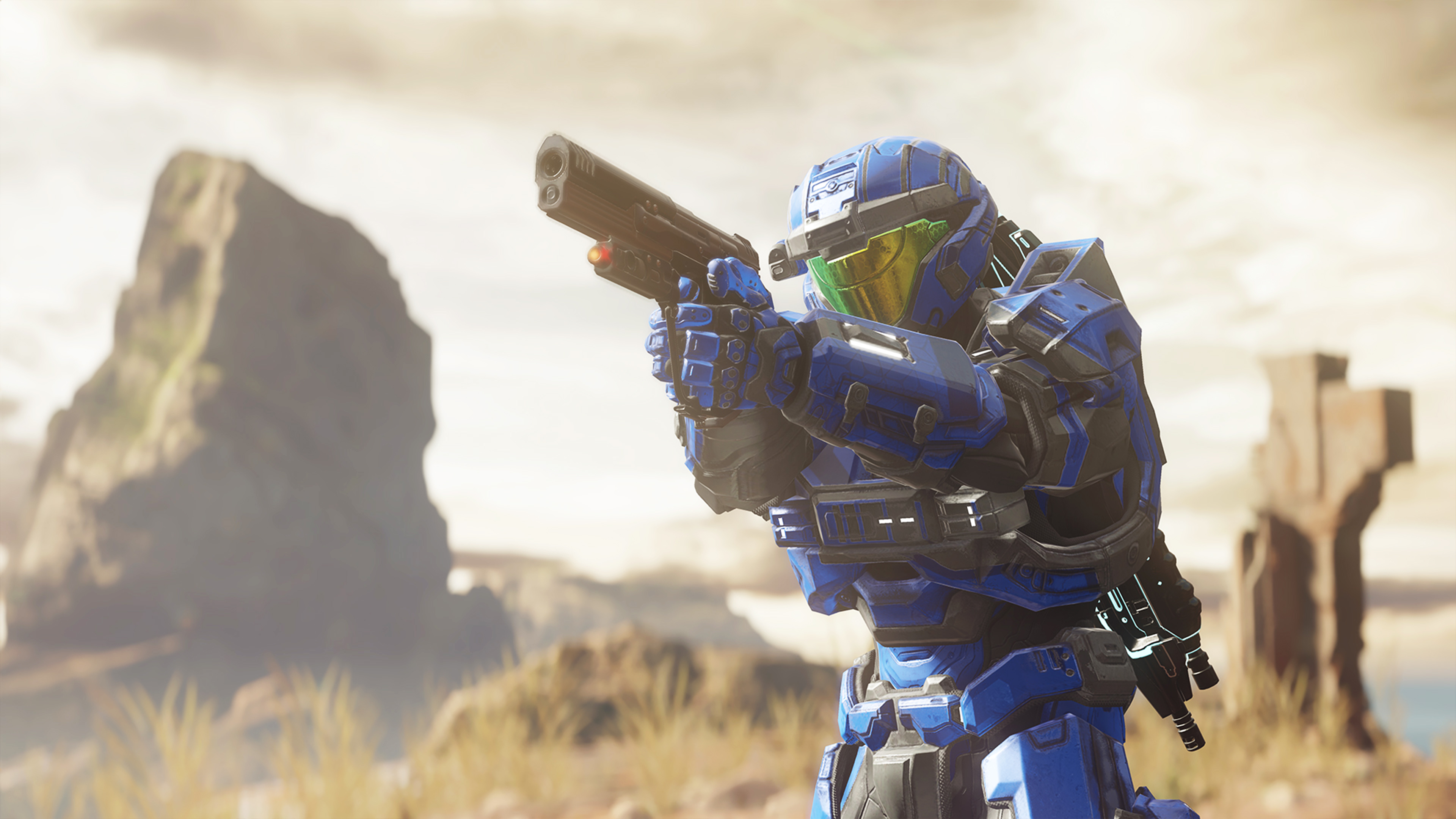
Halo 5 Guardians marks 343 Industries second Halo title, and their first on Xbox One. Guardians has been described as the biggest chapter yet of the sci-fi series, but the story feels underdeveloped and more like a stop-off on the way to something larger. Nevertheless, Master Chief’s proper debut on next-gen hardware still impresses with two distinct multiplayer modes, high production values and the most refined Halo gameplay to date.
While the Guaridans story drastically changes the future of the franchise, Halo 5‘s narrative feels more akin to a second season of Spartan Ops, Halo 4.5, or even just a prologue to Halo 6. That’s not to say that Guardians is bland, but it seldom reaches the heights of the four previous games, or even spinoffs like ODST or Reach. This fact alone could be put down the change of the main playable protagonist. Players assume the role of former ONI agent Jameson Locke, along with his accompanying Spartan Fireteam Osiris for the greater majority of the game. Halo 5‘s story begins with Chief going AWOL against the orders of the UNSC. Players then experience the bulk of the story as Locke, who is sent to ‘hunt down’ the Master Chief.
Halo 5‘s story centres on the appearance of mammoth Guardians and the destruction they are causing across the galaxy. This intergalactic turmoil is closely linked to Master Chief and Blue Team’s disappearance. Previous knowledge of the Halo story is essential, as the game dives right in and makes no attempts to bring you up to speed. Veteran players won’t have any issues keeping pace, but new players might find the story and numerous characters somewhat overwhelming. Most of the story is experienced from Locke’s viewpoint, but unfortunately he isn’t the ideal vehicle for moving the story forward. Locke’s chapters have little exposition, with players simply venturing through linear environments, shooting Covenant and Promethean enemies – the same enemies from Halo 4 – and exclaiming “The Master Chief was here”. Adding to this repetition is the fact that, notwithstanding a few unique situations, Guardians feels too similar to Halo 4‘s level design. Stages just don’t feel as varied or climatic as previous Halo campaigns, with the focus instead on enemy encounters and creating large spaces for firefights.
Whereas all other Halo titles hit their climax early and continued to push the envelope until the end, Guardians only hits its peak towards the conclusion. I just didn’t feel the same level of cinematic intensity, or those ‘holy wow’ moments from previous Halo iterations. The game takes too long to show its true cards, with the main antagonist taking some time to flesh out. The situation with the Guardians wreaking havoc also takes too long to unravel, and despite being one of the most vital narrative points, it almost feels like a secondary plot device. Only when the credits started to role does the whole galaxy feel under threat. The Arbiter’s appearance is poorly executed, if it could be considered anything more than a cameo. Dr Halsey makes a welcome addition to the main cast, but her colourful history with the Spartan program and questionable allegiances are entirely glossed over.
Of Guardians 15 levels, only 3 are experienced from the perspective of Master Chief. These stages are undoubtedly the best parts of Guardians and progress the story more than any of Locke’s missions. 343 Industries decision to sideline Master Chief is a curious one to say the least. Locke just isn’t an engaging character and his accomplishments over the game seem insignificant compared to Master Chief’s achievements. Halo 5’s marketing has portrayed the game as an investigative story, with players hot on the Chief’s tail and attempting to determine why the galaxy’s hero has suddenly gone rogue. A few of Locke’s earlier missions convey this notion of a cat-and-mouse chase, culminating with a tense encounter between the two Spartan characters. However, beyond this chapter – without spoiling the details – the ‘hunt’ becomes entirely pointless, with players simply mowing down enemies in a series of linear environments on their way to a clearly signposted endgame.
While playing as the Arbiter in Halo 2 offered a different and unique experience compared to the Chief’s, and serviced a major part of the story, the same cannot be said for Locke. If 343 are hoping that Locke shall replace the Master Chief, they are off to a rather poor start. His character is better suited to a spin-off title or a side-story like Spartan Ops. Locke’s Spartan troop, Fireteam Osiris, provides the only point of differentiation to the Master Chief, mostly thanks to Nathan Fillion’s great performance as his lookalike character Edward Buck, returning from Halo 3: ODST. Indeed, I feel Buck would have been a much better and relatable character to play as than Locke.
Seeing so little of Chief was certainly a personal disappointment. This could have been alleviated had Chief and Locke’s time been better balanced, or if the ‘hunt’ theme was developed better. Chief’s motivation for leaving the UNSC is never in doubt, so the sense of mystery I was anticipating from the ‘hunt the truth’ campaign was quickly dispelled. In fact, the Master Chief’s viewpoint of the Guardians story is far more interesting, at least from the small glance we’re allowed. It deserved more time and development than it was ultimately given, especially in hindsight after we discover the identity of the main antagonist. Blue Team, Chief’s closest friends outside of Cortana and the only surviving Spartan II’s, accompany him throughout the game. Blue Team have been written about extensively in a number of Halo books, but Guardians marks their first game debut. Halo 5 superbly conveys Blue Team’s unique personalities, as created in the Halo fiction. The banter between Chief and Blue Team establishes the mentality of playing in close-knit squad of Spartan’s and the deep bond they share. The focus on Locke is especially disappointing in light of the stellar portrayal of Chief and his reliance on Blue Team in the wake of Cortana’s departure.
My assessment of the campaign might sound unnecessarily harsh, and that possibly comes from my high expectations as a veteran Halo fan. Guardians ranks as my least favourite campaign in the series, at least as far as the story and level design is concerned. Halo 5 still provides a highly entertaining sci-fi shooter experience. The run and gun gameplay cannot be faulted, nor can the intensity of facing waves of Covenant and Promethean enemies be undersold. As I previously mentioned, environments do little to differentiate themselves, but they are suitably crafted for traditional Halo gameplay. Clambering up ledges with ease and finding new paths to flank the enemy makes for some of the most polished Halo gameplay yet. The AI is some of the most resilient and coordinated that I’ve seen in any Halo. The new bosses are also extremely challenging and satisfying to defeat. I completed the game in 9 hours, playing solo on Heroic difficulty. Legendary shall be a tough exercise for even the most hardened of Halo players.
Halo 5 is ideally aimed at 4-player co-op, and the game is far more entertaining with friends by your side. Vehicular segments are also geared towards co-operatively play. Some of the best fun I had was when players were commanding a vehicle each or I had a gunner in the back of my Warthog. Indeed, I think Guardians‘ story lost its traditional Halo cinematic charm by catering entirely to co-operative play. I feel that Halo 4 took the best approach to co-operative play with Spartan Ops mode. Ultimately, the campaign displays flashes of brilliance, but it feels like a pit-stop on a journey to something bigger. I look forward to seeing Halo 6 capitalising on the threats established in Guardians and hopefully a return to the series story-driven roots.
Whereas the campaign is fun but feels somewhat underdeveloped, Halo 5 more than compensates with its fantastic offering of multiplayer modes. The first, arena mode, is a successful return to traditional Halo multiplayer, spliced with a degree of modernisation. Halo 4‘s despised loadout and armour systems have been ditched, with gameplay now homogenised in favour of a system that priorities skill and balance. You can only change your Spartan’s appearance in arena, hence, all players have the access to the same abilities and guns when a game begins. You can capture power weapons like sniper rifles, which are littered across the map, but this creates a level playing field and encourages teamwork, one of Halo‘s most important multiplayer foundations.
Spartans can execute a raft of new manoeuvres, like a quick boost in any direction or a ground pound. These new abilities add a degree of innovation to Halo‘s multiplayer without breaking the traditional mould. Moreover, Spartan abilities can be challenging to master, encouraging experimenting in order to improve your skill level. Arena’s other new innovations, like smart scope – essentially ADS – are also suitably balanced. Zooming in, for instance, offers no advantages to accuracy over aiming from the hip, and being hit by enemy bullets also de-zooms your view. Another feature, sprinting, is useful for escaping the enemy, but it sacrifices your shield’s ability to recharge.
I rather enjoyed playing all of Halo 5‘s new multiplayer maps. 343 has perfectly designed the multiplayer arenas to facilitate both close-quarter and ranged combat. Environments posses multiple paths and elevations for flanking the enemy. Thankfully, maps don’t suffer based on a particular game mode. In fact, I found that combat flowed different deepening on whether I was playing capture the flag or slayer, for example. Stronghold was also particularly entertaining to play, with each team vying to capture three areas on the map. Thanks to the promise of free future DLC, players shall be able to enjoy a steady stream of new maps post launch.
In essence, the time I have spent in Halo 5‘s arena multiplayer feels like a suitable modernisation with the implementation of new features such as smart-scope. But, in staying true to Halo‘s multiplayer foundations, these additions do not dilute or take away from the classic gameplay formula that fans are accustomed to. As such, 343 Industries have skilfully fused new and old to create a highly refined and enjoyable arena multiplayer experience. During our pre-release testing, we were able to connect to multiplayer matches with ease. We shall continue monitoring Microsoft’s servers post-release and advise on any major changes.
My favourite new addition to Halo 5 Guardians is the new warzone multiplayer mode. Warzone sees two teams of 12 players each battling vying for control of bases, with countless enemy AI and vehicles added for good measure. The mode can be best likened to a Halo ‘Battlefield‘ hybrid. Combining elements of both PVP and PVE, warzone immerses players in a large-scale Halo battle, with the resulting chaos and intensity creating an entertaining mode unlike anything the franchise has seen before.
Each round starts with your team securing a base, before venturing out to capture the enemy’s headquarters. Enemy Covenant and Promethean are littered around the environment, helping to convey the notion of a highly populated battlefield. The environments themselves feel rather large and adequately accommodate 24 players, offering opportunities for everything from vehicular combat to sniping. You win a round of warzone by controlling all the bases, but players on the loosing side can score a last-minute win by destroying the enemy base’s energy core. This constant back-and-forth ensures that there is never a dull moment, and encourages teams to come up with creative strategies for infiltrating the enemy’s lair.
Capturing bases and fighting enemies gives players currency, known as REQ points. Players can also beat mini-bosses, such as Elite Sangheili soldiers, to net a high amount of REQ points. These points can be used for purchasing vehicles and one-time power weapons from REQ stations. Players gain REQ ‘levels’ over the course of a game, granting access to even more powerful tools of war. Calling in a Scorpion tank, for example, can sometimes tip the match in your favour, so being a team player and spending your REQ points wisely is advisable.
Unlike arena, where everything is a level playing field and only cosmetic changes applied, players can purchase REQ packs containing items for use in warzone via micro-transactions. Whether or not these micro-transactions can significantly affect the gameplay balance I’m yet to see. However, given that players are already generously rewarded with REQ points simply for playing and completing objectives, there may not be any need to spend real money. Similarly to arena, our time in warzone has been limited to it’s pre-release state, so we shall keep playing and notify of any major developments.
Visually, Halo 5 Guardians closely resembles what we saw in The Master Chief Collection‘s remastered Halo 4. Disappointingly, there isn’t a large jump in graphical fidelity, but the game isn’t lacking in detail, with well-crafted animations, models and lighting. Guardians primary focus is a steady 60 frames per second, and thanks to a dynamic game resolution that scales based in the intensity of a given level, 343 have overwhelmingly succeeded in delivering a fluid gameplay experience. The voice cast perform admirably, bringing life and purpose to their characters. Steve Downes and Jen Taylor, as Master Chief and Doctor Catherine Halsey respectively, are standouts yet again, in addition to the aforementioned Nathan Fillion.
Kazuma Jinnouchi’s soundtrack also cannot be given enough praise. The composer, who scored the amazing track 117 on the Halo 4 OST, delivers a orchestral experience to rival the work of original Halo composers Martin O’Donnell and Michael Salvatori. Jinnouchi expertly builds on the work of these previous artists. He acknowledges Halo’s musical foundations, but creates an entirely unique and cinematic audio experience. The intensity and emotion conveyed by Jinnouchi’s Halo 5 score is unlike anything I have heard in a video game in some time.
Halo 5 Guardians is a fantastic game brimming with content, though some parts feel better than others. The story fails to live up to the franchise’s standards, due to an underdeveloped narrative, samey level design and an unnecessary focus on Locke. Nevertheless, polished gameplay, challenging AI, the superb portrayal of Blue Team and a mesmerising soundtrack redeem the campaign. Moreover, Guardians possess the best Halo multiplayer yet, with Arena and Warzone offering an intense and entertaining online experience. Arena successfully modernises Halo‘s multiplayer while retaining the traditional gameplay that fans adore. Warzone, meanwhile, is the best addition to franchise in some time, creating epic large-scale Halo battles we’ve only dreamed of playing until now. Ultimately, Halo 5 Guardians is a solid debut for the series on Xbox One, with excellent production values and superb gameplay. Multiplayer ticks all the boxes, and viewing the story as stepping stone on the way to Halo 6, I look forward to Master Chief saving us all again in the future.
Multiplayer | Warzone | Soundtrack | Blue Team | Nathan Fillion
Too much Locke | Not enough Chief | Slow Campaign

